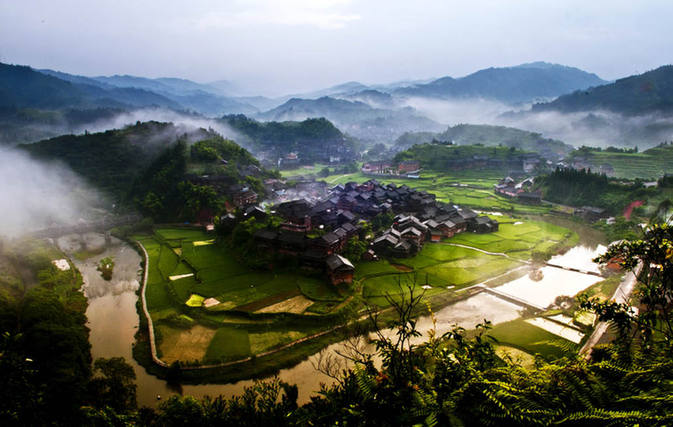Sanjiang – Home of the Dong People
By WU MEILING
Sanjiang is located in northern Guangxi Zhuang Autonomous Region, neighboring Hunan and Guizhou provinces. Here is where the Rongjiang River, Xunjiang River and Miaojiang River meet, hence the county’s name – Sanjiang, literally meaning “three rivers.” Culturally, it was influenced by both the Han people from the north and a range of partially or wholly ethic minority communities from the south. Settled over 1,000 years ago, the county still retains many historical influences with features from different dynasties.

Sanjiang is the only autonomous county of the Dong people in Guangxi. Living off the forest, the Dong developed the mountainsides into terraced fields and tea plantations. Besides tea, Sanjiang is also famed for its numerous festivals, drum towers and wind-and-rain bridges. This range of over 60 ancient theatrical stages, over 120 wind-and-rain bridges, over 200 drum towers and over 500 historical sites, transforms the county into a splendid panorama in southwest China.
If you come to Sanjiang, you should step onto one of the ancient wooden “overpasses” and high drum towers, drink spring tea and enjoy a 100-family dinner, and listen to multi-part folk songs... You will feel like you have entered a Shangri-La – a world where men plow the fields and women weave cloth, living a pure and simple life.
Sanjiang is famous for villages that have retained their original environment and their wind-and-rain bridges. Chengyang Bridge, the eight villages of Chengyang, the Bird’s Nest building of Dong and Danzhou Island are must-see spots here.
Chengyang Bridge is representative of the wind-and-rain bridges of San-jiang. About 20 kilometers north of the county seat, the bridge – 77.76 meters long and 3.75 meters wide – crosses the Linxi River. The corridor and pavilions of the bridge give shelter from rain and wind. The five polygonal tower-like pavilions were built on five piers, piled up with blue stones and standing on the river. The overhanging eaves tilt up like spreading wings. The pillars and eaves are adorned with carvings and color paintings. The bridge, constructed with traditional crafts, has all its parts jointed with a mortise-and-tenon structure. Built in 1924, the bridge is still a key traffic pass where you see elders in traditional dress and toddlers at play.
The eight villages in Chengyang attract travelers by way of their strong Dong culture. Each village has its own wind-and-rain bridge. Moreover, the most characteristic construction is the drum tower – you can find 11 towers in these villages, along with ancient waterwheels and traditional stilt-residences.
If one considers the wind-and-rain bridges, drum towers and stilt-buildings as the three most characteristic architectural styles of the Dong, the Bird’s Nest building must be its most enchanting construction. In appearance, it resembles the steel Bird’s Nest of Beijing’s Olympic Park, and the round Earthen Towers (tulou) of the Hakka in Fujian Province. It is 29 meters high and 88 meters in diameter. All wooden parts are connected by mortise and tenon joints. At each corner is perched a carved bird – harbinger of prosperity and luck. It also acts as the stage for the epic drama Love Song for a Sanjiang Evening, which integrates unique courting and marriage traditions, including traditional dress, and singing in antiphonal style accompanied by modern sound and light technologies.
